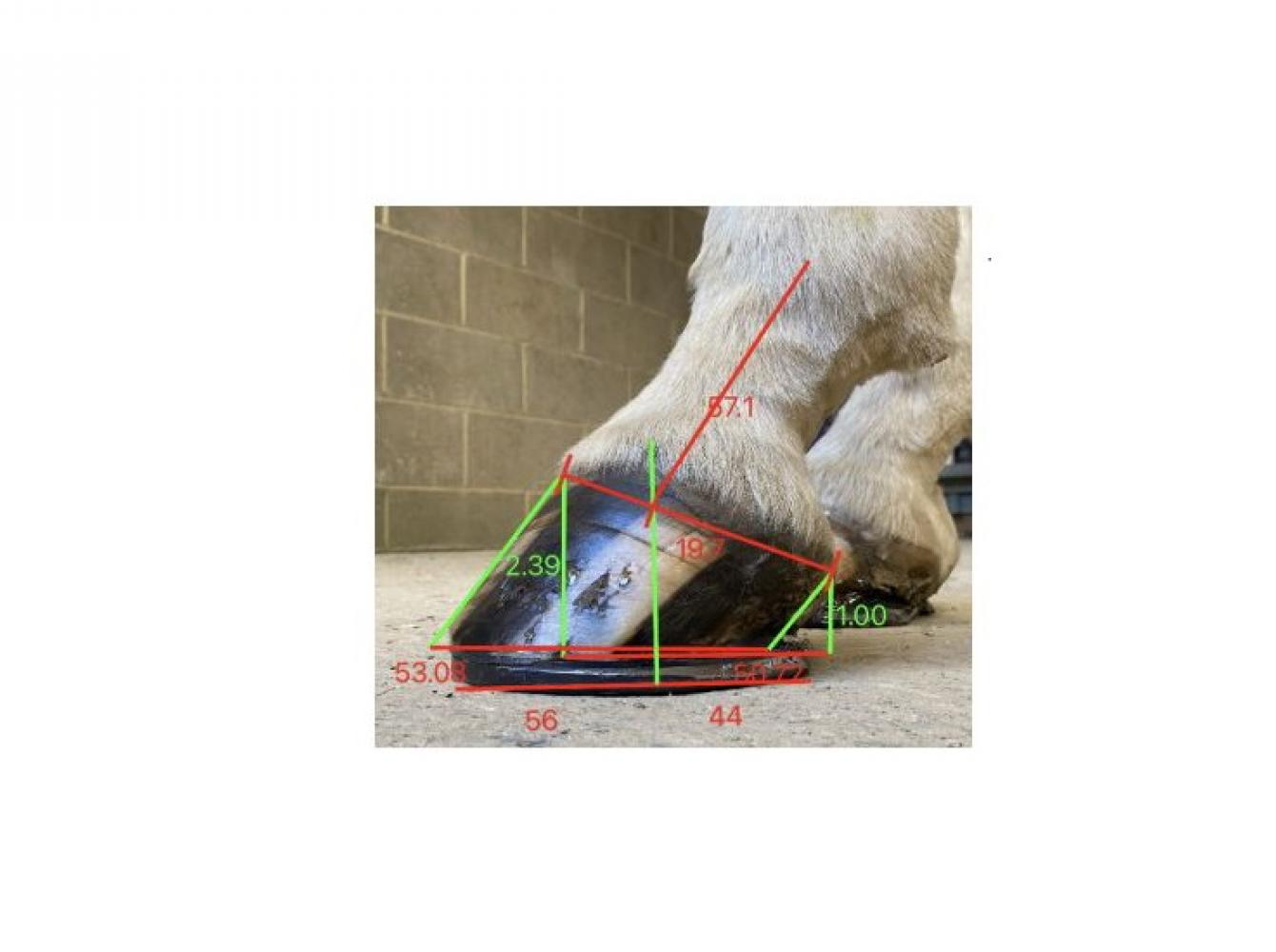
The accuracy of an external template for the assessment of dorsopalmar balance
Pilot study into the accuracy of an external template for the assessment of dorsopalmar balance according to internal structures by Yogi Sharp - the Equine documentalist
Hoof balance has been shown to be an important factor in lameness and catastrophic injury (Kane et al 1998, Dyson 2011). However, there is a low recognition, both by owners and professionals, of the external reference points that can be used to assess hoof balance in the absence of radiographs. Mannsman et al (2000) quantified the lack of recognition of poor external hoof proportions. The study found only 10% of 50 randomly radiographed horses presented with radiographs that were considered normal. 40% of the horses were in a category that included inadequate caudal support and/or poor palmar angle. Mannsman et al (2000) discussed how to enable preventative hoof care, owners need to be made aware of any potential or existing foot problems. Providing the farrier with a tool to show and assess balance can aid shoeing decisions and encourage positive interaction among the owner–farrier–vet team quickly and practically. An easily accessible and cost-effective source of external templates that can be used to quickly assess hoof balance, from a lateral photograph, could help recognition of poor dorsopalmar balance earlier, before radiographs become necessary due to lameness. This could educate the owner, train the farriers’ eye and enable objective documentation and aid intervention decision making. This study sought to test a template within an app as a tool to provide hoof balance information.
Predispositions of Poor Hoof Balance
Dyson (2011) stated that the ratio of dorsal to palmar coronary band heights and the shape of the coronary band were significantly different between lame and non-lame horses and this proportional relationship is a measure of dorso-palmar balance. Hoof proportions are directly linked to digit proportions. Poor dorso-palmar balance, leading to a broken back hoof pastern axis (BBHPA), has been shown to predispose the horse to navicular syndrome. Waguespack and Hanson (2010) outlined the biomechanical considerations of a BBHPA and stated that the primary source of pressure on the navicular bone (NB) is compression from the deep digital flexor tendon (DDFT), Ruff et al (2016) expanded on this, expressing the increased compressive force on the navicular bone from the deep digital flexor tendon (DDFT) in conformations exhibiting increased dorsiflexion. This was supported by Uhl et al (2018) which stated conformations described by Ruff et al (2016) as being mechanically predisposed to navicular and that DDFT lesions corresponded with areas of increased load. Many other papers have expressed the importance of a good HPA, (Witte (2013), Zani et al (2015), Logie (2018) and Brown (2020), outlining its importance in optimal performance and the predispositions of a BBHPA. These studies show the importance of hoof proportion, dorso-palmar balance and HPA, and the need for its regular assessment for the prevention and treatment of injury. In the author’s work a high percentage of cases present with a BBHPA and poor dorso-palmar balance, showing that owners and often their farriers have some recognition that their horses feet do not appear ideal but lack something to quantify their suspicions.
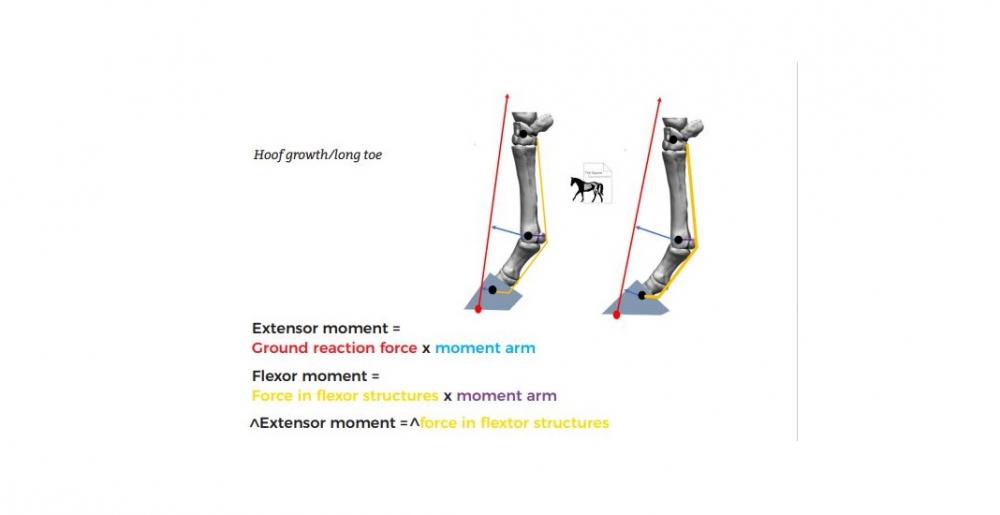
Fig.1 The increase in extending moment caused by poor hoof proportions and the forward migration of the centre of pressure, showing how the centre of pressure is subject to hoof proportions, it moves dorsally and away from the centres of rotation as the toe lever arm increases. This increases the extending moment and collapsing force on the limb which has to be counteracted by the strain within the flexor structures. This shows the importance of recognition of hoof proportions around the centre of rotation (Image reproduced by permission of R.Weller)
The proportions of the hoof directly affect the HPA and have a direct influence on flexor structure strain. Page and Hagan (2002) discussed the distance between the distal phalanx and the toe and how it directly affected HPA, Redden (2003) took this measurement and expressed how it created toe leverage when it was too great, causing toe flares. Dr Weller discussed the biomechanical implications on the flexor structures from a long toe lever arm. Hoof proportions and landmarks Snow and Birdsall (1990) and Dyson et al (2011) discussed how a difference in angle between the hoof wall and heel greater than 5° suggested a collapsed heel, affecting HPA. However, this is questioned by anecdotal evidence, and Powell (2006) and Caldwell et al (2016) suggest a wider range of heel:toe angle differences within a range of normality. Turner (1992) and Dyson et al (2011) mention the established ideal of there being a 3:1 toe:heel height ratio and that this ratio affected the angle of the hoof, inevitably this will affect HPA. However, the authors own experiential opinion and anecdotal evidence, supported by Caldwell et al (2016) would question the 3:1 ratio in light of natural variation. These studies suggest, however, that measuring external proportions can play a role in determining hoof balance, and Dyson et al (2011) showed how external assessment of the hoof can give good indication of its predisposition to pathology. While heel:toe proportions require further research to establish ranges of normality, other proportional measurements are more established. There have been studies into external reference points for recognising internal landmarks that are important for creating efficient biomechanics around, to reduce the risk of injury. Duckett was the first to establish external reference points in relation to internal anatomical points of interest. Caldwell (2016) discussed, summarised and tested the importance and accuracy of these external reference points such as Duckett’s dot and the external centre of rotation, achieved by foot mapping. Caldwell (2016) discussed Duckett’s theory, which stated that balance was theoretically achieved by way of proportional measurements and Duckett encouraged proportional optimisation around the internal anatomy. Caldwell (2016) found that the external reference point centre of rotation, was related to the position of the internal location of centre of rotation (CoR) of the distal interphalangeal joint (DIPJ) and stated that creating proportional dimensions around this point, on an individual basis, was a good model for creating biomechanical efficiency. This supported O’Grady (2006) who expressed how shoeing to place the CoR in the middle of the base or shoe was biomechanically optimal and this practice is widely accepted as an ideal for farriery intervention. Shoeing to create equal distance from heel to breakover from CoR is widely advocated by leading podiatrists such as Dr Myers and EPC Solutions, as well as Dr Redden among others. Although the optimum proportions of the foot differ between shod and barefoot and different authors, the common denominator is the use of CoR as the datum point. Caldwell (2018) discussed how the widely accepted 50:50 geometric post-trim proportions of the bearing border around CoR advocated by Colles et al (1983; 1989) contrasted to the theories of Jackson (1992) and Ovnicek (2003), whose trimming methods consistently created proportions of 60:40 around CoR in the barefoot horse. Trimming on an individual basis, accounting for phalangeal alignment as well as proportional hoof measurements has become the author’s preferred method and is supported by Caldwell et al (2016). This could create a range of barefoot proportional measurements around CoR; however, many practitioners and published papers, going back to the theories of Duckett, point toward creating 50/50 around CoR when shod. The external CoR is found by different foot mapping methods, some of which require certain external anatomy to be visible, for example, the inner edge of the white line (Caldwell 2018). This is no longer possible when shod and can not be assessed from a lateral view. Ferrie (2007) discussed a method for establishing CoR from a lateral view, again highlighting the importance of balance around this point. It stated that when divided into thirds, the transition point from the first to second third from the toe correlated with the CoR. Berger (2017) discussed balance around the CoR as a method that optimises the biomechanics of the hoof and tested Ferrie’s reference point. The study found that the coronet band marker had the smallest mean difference from mark to CoR; however, it also had the largest standard deviation. Further research could prove it to be an accurate reference point in finding the CoR within a working tolerance.
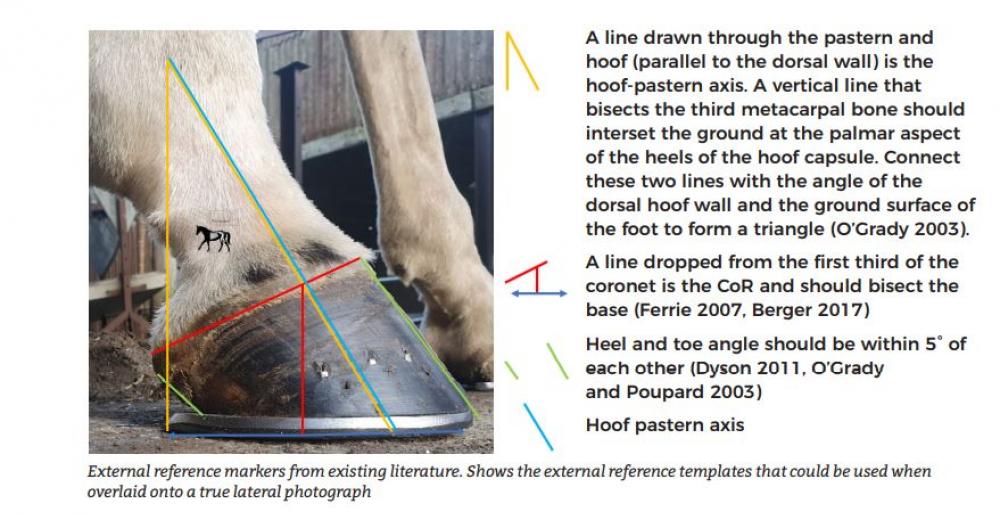
In order to use this reference point a true lateral photo of the hoof is needed. Dyson (2011) cited earlier studies, stating that digital photography provides an accurate method of measurement of hoof conformation and has been shown to be superior to hoof angle measuring devices (Moleman et al 2005). White et al (2008) tested the practicability, precision and accuracy of the process of obtaining measurements of horses’ feet using photography. Excellent precision was identified within and between operators regardless of image origin. High levels of accuracy were also identified, especially for heel height/toe height ratios and coronary band angle, indicating that photography and radiography may be used interchangeably. The photographic technique included visually aligning the heel bulbs as is done when obtaining lateromedial radiographs (Kummer et al 2004) and supporting the camera at the same level as the foot. This shows that subject to protocols in image acquisition, quantified templates overlaid on lateral photographs could provide accurate assessment of hoof balance. The external reference points that have been outlined by studies to suggest ideal geometric proportions for optimal dorso-palmar balance, from a lateral external view are as follows.
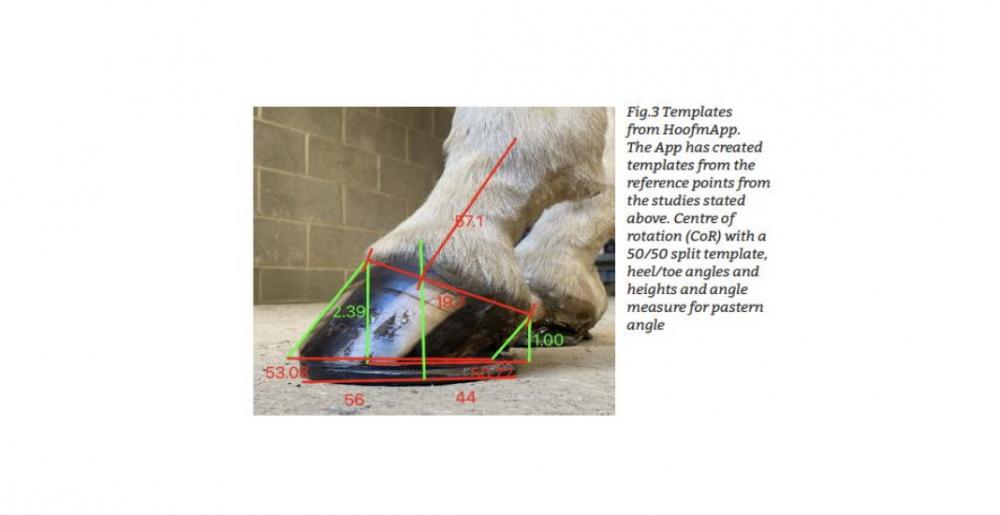
HoofmApp
HoofmApp is a hoof balance measuring app that the author has been working on as part of the Hoofinnovations group. This study was undertaken as part of the testing process and is the first of a series of studies to test the efficacy of the app in daily practice. Of these reference points, considering the importance attributed to shoeing around the CoR by the aforementioned studies, the ability to know, accurately, where the CoR is from a lateral view could prove to be a valuable piece of information for assessing farriery intervention and becomes the foundation for proportional assessment. CoR at one-third the length of the hairline has been researched by Ferrie (2007) and Berger (2017). By placing the hoof on a horizontal surface, a calliper was placed on the coronary band from the centre of the toe to the bulbs of the heels and this was recorded as the total coronary band distance. A line was dropped perpendicular to the ground from the point dividing the cranial and the middle one-third of the total coronary band distance. The line was continued across the solear surface to the middle of the frog where a small nail-marker was inserted. Berger (2017) found this method had a mean difference from nail-marker to CoR of 3.8 mm, the smallest mean difference of the two methods tested. While this method is practical for using the external reference point in daily practice, it could create potential margin for human error in assessing its accuracy, as the lines drawn would have to be perfectly straight and perpendicular to the ground surface to be completely accurate. A study overlaying a template straight onto a radiograph could reduce human error and more accurately assess the external reference points distance from the anatomical CoR.
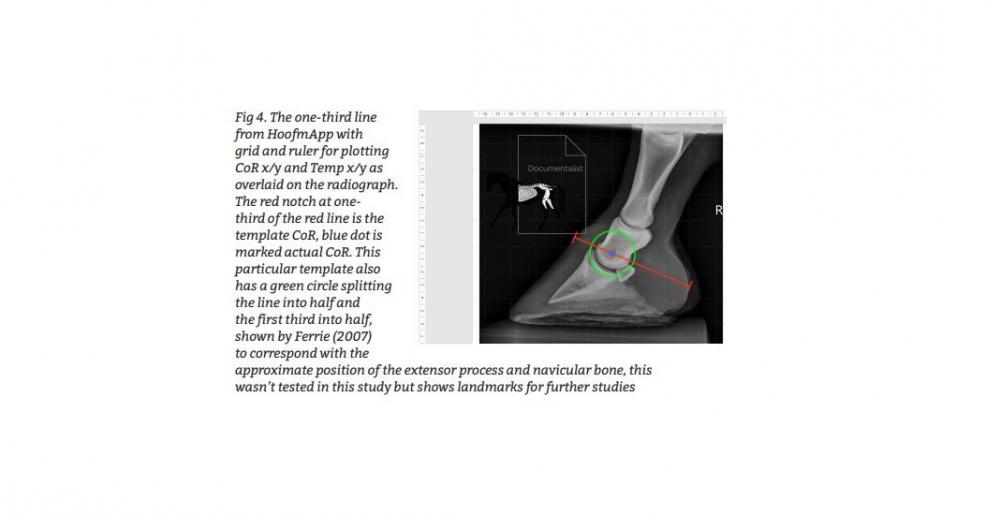
Materials and methods
Using a template from HoofmApp a line with a measurement one-third from the cranial aspect of a radiograph was overlaid onto 23 radiographs. The template was placed at the hairline at the dorsal toe and followed caudally to the bulb of the heel. A grid and ruler option was used to plot the X and Y coordinates of the anatomical CoR (CoR x and CoR y) versus the template CoR (Temp x and Temp y). Radiographs were included in the study if they were true laterals with minimal ‘shadowing’ at the joint spaces and the hairline junction was visible to enable as accurate template placement as possible. Laminitic radiographs were not included. Results A paired equivalence test with the upper and lower limit of the smallest unit of measure in the grid and ruler system was used. The confidence interval was well within the equivalence interval for both the x and y axis’ coordinates.
Discussion
This study sought to establish the accuracy of a template, based on Ferrie (2007), overlaid onto a lateral photograph in expressing the internal position of CoR. To establish the templates efficacy overlaid on a lateral photo, its accuracy was tested overlaid onto a radiograph to show its margin of error as White et al (2008) expressed the interchangeability of correctly taken lateral photographs with lateral radiographs. The results were in line with previous findings (Berger 2017), showing that the proportional measurement of the hairline, corresponded well with the internal CoR and that a template of this measurement overlaid onto a radiograph showed equivalent (P 0.000) position of CoR. The findings of this study suggest that the CoR template enables accurate determination of the internal CoR, subject to correct photography of the digit. As an important datum point for proportional assessment of hoof balance, other templates of established balance parameters added to the template CoR could provide accurate documentation of pre and post farriery intervention. While there are technologies providing measurements of the external hoof, these can be expensive, time consuming and not readily available to a large proportion of the farriery, vet, practitioner and indeed horse-owning community. Caldwell et al (2016) clearly showed the individuality of hooves. Therefore, what makes them balanced are the proportions of the hoof around CoR and not dictated numerical ideals. A set of proportional templates could therefore prove to be more practically applicable then the ability to measure fractions of degrees and liner measurements. Recognising balance around CoR requires datum points that help to highlight morphological changes in the hoof capsule. Every farrier has the ability to take lateral photographs of the hoof and this study suggests the app could provide the accurate position of CoR to enable self-assessment, documentation of morphology and discussion between them, owners, practitioners and vets, aiding in formulating pro-active shoeing plans. As a pilot study, limitations were evident, although the radiographs were selected for minimal shadowing there was still obliquity in a percentage of the radiographs and ideally future studies would strictly use podiatry radiographs correctly centred. No radio-opaque markers were placed along the hairline, which created some subjectivity of the positioning of the CoR template. Future studies could more accurately and objectively prove this studies’ findings using a radio opaque substance along the hairline for completely accurate placement of the CoR template. Future studies could also determine the inter-user agreement of placement of the CoR template as well as the subsequent templates. However, all measuring technologies are subject to human error in placement, they are accurate subject to correct use.
Conclusion
Recognising hoof balance is an important factor in maintaining healthy and optimally functioning hooves. However, Mannsman et al (2000) showed that 66% of horses in their cohort had potential problems that were not known or were not being addressed by the owner, farrier or primary care vet. The study suggested the use of regular radiographs for objective hoof assessment and to aid in client-vet-farrier communications. With the findings of White et al (2008) and the statements of Dyson (2011) that correctly taken lateral photos provide an accurate base for hoof balance assessment, the addition of objective templates overlaid onto lateral photos could further advance the assessment and documentation of hoof balance while providing an objective communication tool for all parties involved in the care of horse.
References
BERGER, H. (2017) Use of external landmarks as reference points for location of the internal structures within the hoof capsule, FWCF thesis. https://www.wcf.org.uk/fwcf-thesis?tid=e2da21c5b0830ae284b20add53 02de3852aba153c538243bcc1fa8fe7622341e Accessed 25/08/2021
BROWN, S.-M. (2020), Feet from a different angle, Equine Health 51 11-12
CALDWELL, M. N. (2018) The effects of equine hoof morphology on pathologies of the foot, PhD thesis
CALDWELL. M. N., ALLAN. L. A., PINCHBECK. G. L., CLEGG, P. D., KISSICK, K. E. & MILNE. P. I. (2016) A test of the universal applicability of a commonly used principle of hoof balance, The Veterinary Journal 207 169-176 COLLES, C. M. (1983) Interpreting radiographs 1: the foot. Equine Veterinary Journal 15 297– 303
COLLES, C. M. (1989) A technique for assessing hoof function in the horse. Equine Veterinary Journal 21 17-22
DYSON. S., TRANQUILLE. C., COLLINS. S., PARKIN. T. & MURRAY. R, (2011) External characteristics of the lateral aspect of the hoof differ between non-lame and lame horses, The Veterinary Journal, 190 364-371 ISSN 1090-0233 https://doi.org/10.1016/j.tvjl.2010.11.015.
FERRIE, J., (2007) Shoeing around the coffin joint. [Online] Available at: http://www.forgeandfarrier.co.uk/shoeingaroundcoffinjoint.htm
KANE at al (1998) Hoof size, shape and balance as possible risk factors for catastrophic musculoskeletal injury thoroughbred racehorses, American Journal of Veterinary Research 59 1545-1552
KUMMER, M., LISCHER, C., OHLERTH, S., VARGAS, J. & AUER, J. (2004) Evaluation of a standardised radiographic technique of the equine hoof. Schweiz Arch Tierheilkd 146 507-514
LOGIE.S. (2018) The role of radiography in equine foot balance Equine Health 39 18-20
MANSMANN. R., KING. C. & STEWART. E. (2000) How to develop a preventive foot care program — a model, American Association of Equine Practitioners proceedings
MOLEMAN, M., VAN HEEL, M., VAN DEN BELT, A. & BACK, W. (2005) Accuracy of hoof angle measurement devices in comparison with digitally analysed photographs. Equine Veterinary Education 17, 319–322
O'GRADY, S. E., (2006) Strategies for shoeing the horse with palmar foot pain. Proceedings 52nd annual convention of the American Association of Equine Practitioners 209
O'GRADY. S. E. (2013) How to evaluate the equine hoof capsule, American Association of Equine Practitioners Convention Proceedings
O’GRADY, S. E. & POUPARD, D. A. (2003) Proper Physiologic Horseshoeing, Veterinary Clinics of North America Equine Practice 19 333-351
OVNICEK.G., PAGE. B. & TROTTER. G. (2003) Natural balance trimming and shoeing: its theory and application. Veterinary Clinics of North America: Equine Practice, 19 353-377 ISSN 0749-0739, https://doi.org/10.1016/S0749- 0739(03)00017-8.
OVNICEK, G., ERFLE, J. & PETERS, D. (1995) Wild horse hoof patterns offer a formula for preventing and treating lameness. Proceedings of the American Association of Equine Practitioners 41 58–260
OVNICEK, G. (2003) Natural balance trimming and shoeing: appearance of a self maintained foot, In: Lameness in the Horse, editors M. Ross and S. Dyson, W. B. Saunders, St. Louis. 271-273
PAGE.B., & HAGAN. T., (2002) Breakover of the hoof and its effect on structures and forces within the foot, Journal of Equine Veterinary Science 22 258-263 POWELL, C. (2006) Difference in toe and heel angles, FWCF thesis, https://www.wcf.org.uk/fwcf-thesis?tid=186c76fef2fa64f520746499bc2d e115bc40b340adf6362381686d4204dc46b3 Accessed 25/08/2021
REDDEN, R. F. (2003) Hoof capsule distortion: understanding the mechanisms as a basis for rational management. The Veterinary Clinics of North America. Equine Practice 19 443-462. doi: 10.1016/s0749-0739(03)00027-0. PMID: 14575168.
RUFF. K.C, OSBORN. M.L, UHL. E.W, 2016, Analysis of Forces Acting on the Equine Navicular Bone in Normal and Dorsiflexed Positionshttps:// www.fasebj.org/doi/abs/10.1096/fasebj.30.1_supplement.923.4
SNOW, V. & BIRDSALL, D. (1990) Specific parameters used to evaluate hoof balance and support. Proceedings of the American Association of Equine Practitioners 36 299-311
TURNER, T. (1992) The use of hoof measurements for the objective assessment of hoof balance. Proceedings of the American Association of Equine Practitioners, 38 389-395
UHL. E. W, BLAS-MACHADO. U., KIREJCZYK. S. G. M, OSBORN. M. L. (2018) Correlating increased mechanical forces with tissue lesions in equine navicular disease https://www.fasebj.org/doi/abs/10.1096/ fasebj.2018.32.1_supplement.816.14
WHITE, J. M., MELLOR, D. J., DUZ, M. , LISCHER, C. J. & VOUTE, L. C. (2008) Diagnostic accuracy of digital photography and image analysis for the measurement of foot conformation in the horse, Equine Veterinary Journal 40 623-628 doi: 10.2746/042516408X313625
WAGUESPACK, R. & HANSON, R. R. (2010) Navicular syndrome in equine patients: anatomy, causes and diagnosis, Surgical Views, https:// www.vetmed.auburn.edu/wp-content/uploads/2015/01/PV1110_ waguespack_Surgical.pdf Accessed 25/08/2021
WAGUASPACK, R. & HANSON, R. R. (2011) Treating navicular syndrome in equine patients, https://pdfs.semanticscholar.org/d1db/ f7122c6cbca37544466b188e600c39ce4dc5.pdf Accessed 02/04/2020
WAGUESPACK, R. & HANSON, R. R. (2014) Navicular syndrome in equine patients: anatomy, causes and diagnosis, https://www.vetmed.auburn. edu/wp-content/uploads/2015/01/PV1110_waguespack_Surgical.pdf Accessed 02/04/2020
WITTE, T., (2013) Getting the right balance Equine Health 12 13-17